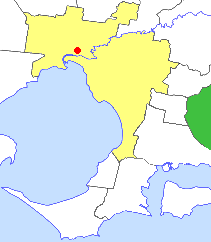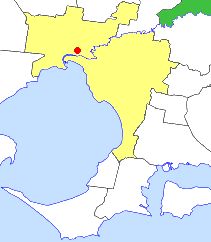
Burnham Beeches is a 1930s streamline-moderne mansion built for Aspro sales magnate Alfred Nicholas [1] on Sherbrooke Road, Sherbrooke, Victoria in the Dandenong Ranges, 40 kilometres (25 miles) from Melbourne, Victoria, Australia.

Burnham Beeches is a 1930s streamline-moderne mansion built for Aspro sales magnate Alfred Nicholas [1] on Sherbrooke Road, Sherbrooke, Victoria in the Dandenong Ranges, 40 kilometres (25 miles) from Melbourne, Victoria, Australia.


Built during the late 1920s and 1930s, the property was named after the English National Forest of Beech trees in the county of Buckinghamshire, near the location of Nicholas's United Kingdom Aspro factory.
The architect was Harry Norris, who had toured Europe and America in 1929 for G J Coles to research the latest elements in chain-store design and construction before he finalised the plans for Coles store No. 12, the Bourke Street store, in Melbourne. Nicholas and Norris were neighbours in Melbourne, and Norris was engaged to design a house with the brief that it was to have “fresh air, sunshine and an outlook of command, yet under control”. Nicholas visited the Chelsea Flower Show in 1929, obtained many plants and engaged a Cornishman, Percival Trevaskis, to do the landscaping.
Norris’s design was for a three-storey mansion in the Art Deco Streamline Moderne style. The house was completed in 1933. The lines are said to be reminiscent of an ocean liner. The zig-zag motif was used as decoration on the decorative wrought-iron work and the balcony balustrades. The exterior of the house was of reinforced concrete, painted white and decorated with Australian motifs of koalas and possums in moulded relief panels.
A contemporary journal article cited in a 1980s pamphlet [2] stated that the house included a “private theaterette with talkie equipment”, an “electric pipe-organ” in the music room, orchid houses, a dairy with “prize Jersey cows”, and the gardens included artificial waterfalls, a lake and floodlighting at night.
Nicholas died in 1937 and was survived by his widow, Isabel and two children. [3]
In 1941, during World War II, the house was loaned as a children’s hospital. After the war from 1948-50 it was redecorated by Nicholas’s widow. Mrs Nicholas moved from the house to Toorak in Melbourne in 1954. Two additional wings called the Garden and Forest wings were constructed during the 1950s and 1960s.
From 1955, the Nicholas Institute used the house as a research facility. The gardens, having been named the ‘Alfred Nicholas Memorial Gardens’, were donated to the Shire of Sherbrooke in 1965 and were transferred to the Forests Commission of Victoria in 1973. In 1981 the house was sold and operated as a small hotel for about a decade.
The hotel was last operated by Adrian Zencha (Aman Resorts) in 1991. A group of investors commenced works in 2005 but ceased those works in 2008.
The property was purchased in 2010 by investor Adam Garrisson (Oriental Pacific Group) [4] and chef and restaurateur Shannon Bennett.
The pair have proposed to utilise the buildings and grounds to create a "sustainable resort" with hotel, spa, wellness centre, villas, café, bakery, function areas and restaurant. The proposal is ambitious with much residential accommodation included, and is therefore proving to be contentious because of the possible adverse impact on existing residents and the overall very special nature of the Sherbrooke/Dandenongs region; there are also concerns over health and safety issues such as traffic management and bushfire response. The proposal was rejected pending further information at the Yarra Ranges Council meeting of 11 August 2015.
In March 2019, Burnham Beeches was transformed into an art installation by street artist Rone aka Tyrone Wright, ahead of its conversion into a luxury hotel beginning in mid-2019. [5]

The Shire of Yarra Ranges, also known as Yarra Ranges Council, is a local government area in Victoria, Australia, located in the outer eastern and northeastern suburbs of Melbourne extending into the Yarra Valley and Dandenong Ranges. It has an area of 2,468 square kilometres (953 sq mi), of which 3% is classified as urban. In June 2018, it had a population of 158,173.

The Shire of Cardinia is a local government area in Victoria, Australia, in the south-east of Melbourne between Western Port and the Yarra Ranges on the outskirts of Melbourne. It has an area of 1,283 square kilometres, and had a population of 107,120 in June 2018.

Lysterfield is a suburb in Melbourne, Victoria, Australia, 32 km south-east of Melbourne's Melbourne CBD, located within the City of Knox and the Yarra Ranges Shire local government areas. Lysterfield recorded a population of 6,681 at the 2021 census.

Belgrave is a town and outer suburb in Melbourne, Victoria, Australia, located 36 km east of Melbourne's central business district, within the Shire of Yarra Ranges local government area. Belgrave recorded a population of 3,894 at the 2021 census.
Ferny Creek is a suburb in Melbourne, Victoria, Australia, 33 km south-east of Melbourne's central business district, located within the Shire of Yarra Ranges local government area. Ferny Creek recorded a population of 1,524 at the 2021 census.

Sassafras is a locality and township within Greater Melbourne, beyond the Melbourne metropolitan area Urban Growth Boundary, 43 km east of Melbourne's Central Business District, located within the City of Knox and Shire of Yarra Ranges local government areas. Sassafras recorded a population of 970 at the 2021 census.
Sherbrooke is a settlement in Victoria, Australia, 35 km east of Melbourne, located within the Shire of Yarra Ranges local government area. Sherbrooke recorded a population of 294 at the 2021 census.

Upwey is a suburb of Melbourne, Victoria, Australia, 33 kilometres (21 mi) east from Melbourne's central business district, located within the Shire of Yarra Ranges local government area. Upwey recorded a population of 6,818 at the 2021 census.

Melbourne is Australia's second largest city and widely considered to be a garden city, with Victoria being nicknamed "the Garden State". Renowned as one of the most livable cities in the world, there is an abundance of parks, gardens and green belts close to the CBD with a variety of common and rare plant species amid landscaped vistas, pedestrian pathways, and tree-lined avenues, all managed by Parks Victoria.

Upper Ferntree Gully is a suburb of Melbourne, Victoria, Australia, 32 km east of Melbourne's Central Business District, located within the City of Knox and Shire of Yarra Ranges local government areas. Upper Ferntree Gully recorded a population of 3,417 at the 2021 census.
Harry Albert Norris was an Australian architect based in Melbourne, Victoria. He was especially known for his 1930s Art Deco and Streamline Moderne commercial work in the Melbourne central business district, and was one of the most prolific and successful interwar architects in the city.
Tyrone Wright, better known by his pseudonym Rone, is an Australian street artist based in Melbourne.

The Shire of Pakenham was a local government area about 60 kilometres (37 mi) southeast of Melbourne, the state capital of Victoria, Australia. The shire covered an area of 874 square kilometres (337.5 sq mi), and existed from 1862 until 1994.

The Shire of Lillydale was a local government area about 40 kilometres (25 mi) northeast of Melbourne, the state capital of Victoria, Australia. The shire covered an area of 397.49 square kilometres (153.5 sq mi), and existed from 1856 until 1994.

The Shire of Sherbrooke was a local government area about 40 kilometres (25 mi) east of Melbourne, the state capital of Victoria, Australia. The shire covered an area of 191.66 square kilometres (74.0 sq mi), and existed from 1963 until 1994. Its largest population centre was the town of Belgrave.

The Shire of Upper Yarra was a local government area centred on the upper reaches of the Yarra Valley, about 60 kilometres (37 mi) east of Melbourne, the state capital of Victoria, Australia, extending eastwards into Victoria's interior. The shire covered an area of 1,732 square kilometres (668.7 sq mi), and existed from 1888 until 1994.

The Shire of Healesville was a local government area about 60 kilometres (37 mi) northeast of Melbourne, the state capital of Victoria, Australia. The shire covered an area of 466.20 square kilometres (180.0 sq mi), and existed from 1887 until 1994.

The Majorca Building is a historic office building in Melbourne, Australia, completed in 1930. Located at 258-260 Flinders Lane, it was designed by Harry Norris in an exotic Spanish /Moorish style, in strongly coloured faience.

Hugh Linaker (1872–1938) was a gardener and landscape gardener, who worked on various local and state government projects in the State of Victoria, Australia.